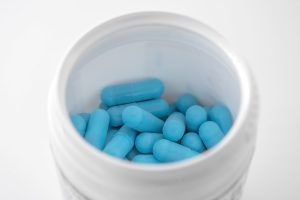Yeast infections can occur in many areas of the male body, including genitalia. Read on to learn more about penile yeast infection and information regarding this medical condition, such as:
- Symptoms
- Types
- Causes
- Contagiousness
- Risk factors
- Complications
- Prevention
- Treatment (both medical and home remedies)
- How long the infection lasts
What Is a Penile Yeast Infection?
As hinted above, this yeast infection is located around the penis and testicles. The condition is caused by an overgrowth of a fungus (yeast) naturally found on a person’s skin.
Although this kind of male infection in the reproductive organs is common in women (which is medically known as candidiasis) – for example, vaginal yeast infection.
However, men aren’t prone to the medical condition. Yeast infection found around the penile area is called candida balanitis or balanitis thrush.
What Are Penile Yeast Infection Symptoms?
This male infection often displays itself via the following signs:
- Soreness, swelling, or redness of the penis
- White patches or small red spots at the top of the penis
- Itchiness
- Difficulty pulling back the foreskin
- Cracked foreskin
- White discharge under the prepuce or other folds of skin
- Burning feeling when urinating
- Discomfort or pain during sexual intercourse
However, pain, itchiness, and redness in the penis may point to other serious medical conditions, such as sexually transmitted infections (STIs). Hence, once these signs appear, set an appointment with a urologist or your primary care doctor.
Types of Male Yeast Infections
The most common type of this yeast infection is candidal balanitis, which results in the inflammation of the penis’s head. For men who aren’t circumcised, balanitis may affect the foreskin. In this case, the male infection is medically called candidal balanoposthitis.
What Causes a Penile Yeast Infection?
As mentioned earlier, everyone has a chance of being infected by this yeast infection since it’s caused by a common fungus: Candida Albicans. In fact, Candida Albicans may already be found in your mouth, moist parts of the skin, or digestive tract, although it’s only a small amount. For women, the fungus is usually found in their vaginas.
Candida albicans are usually benign. However, if the fungus grows too much in a particular area, it’ll become a yeast infection. When the fungus thrives in the mouth, it’s called oral thrush. For men, if candida Albicans grows on the tip of their penis, it’ll lead to balanitis.
Is Male Yeast Infection Contagious?
The short answer is: yes. Having sex with an infected person may lead to transmission of the infection to the partner. Also, if your partner has balanitis, then it’s very likely that you’ll be infected as well.
Keep in mind that performing sexual intercourse with the male infection isn’t only unhygienic and unbearable, but it can also lead to the following consequences:
- Make any medication or cream you’re taking to treat infection less effective
- Longer healing time
- Further, irritate the condition
What Are the Risk Factors for this Infection?
More often than not, men will suffer from penile yeast infection if they have had sex with someone who has balanitis. Sexual intercourse isn’t the only cause of balanitis. In fact, men increase their odds of developing this type of infection if they:
- Don’t regularly clean their genitals
- Have a fragile immune system as a side effect of other conditions or specific medications
- Overdosing on antibiotics
- Often wearing tight underwear or wet clothing
- Use soaps or other skin products that can irritate their skin
- Have diabetes
- Have obesity
- Use lubricated condoms
- Aren’t circumcised
What Are the Complications of Yeast Infection?
If symptoms persist or the infection spreads despite treatment, then there’s a chance that the condition has already turned either into chronic candidiasis or balanitis.
Invasive candidiasis
This serious medical condition is often a result of a weak immune system. If you have a weak immune system and candida balanitis, the fungus may have already spread into your blood. The odds of getting it increases if you:
- Have diabetes
- Have HIV
- Are you having radiation or chemotherapy
- Require dialysis
- Are you taking immunosuppressants that silence your immune system
- Have a central venous catheter –– a tube in your chest so you’ll receive
An upset stomach, headache, high fever, and chills are indicators that the infection has already spread to your bloodstream. Hence, if you’re experiencing these signs, call a doctor immediately.
Balanitis
Balanitis is the most common and potential complication of this yeast infection. Balanitis refers to the inflammation of either the penis’s foreskin or head. If either of these parts is infected, it’ll make urinating difficult and painful.
If left untreated or not treated effectively, balanitis can cause scarring on the foreskin and adhesions on the penis. Also, balanitis can be responsible for fatigue and weakness and cause painful and swollen glands.
How Do You Prevent Penile Yeast Infections?
One of the major ways to prevent this yeast infection is to refrain from having sex with someone infected with candida balanitis. Also, if you have the infection, ensure not to have sex with your partner. Doing so may infect your partner, who can also pass it back to you.
To lower or eliminate the odds of getting the penile yeast infection or passing it to someone else, make sure to follow these safety precautions:
- Wear an external condom every time you’re about to have sex.
- Always practice good hygiene. This includes keeping your penis clean and dry.
- If you’re uncircumcised, make sure to also practice good hygiene under your foreskin, which involves using soap and water. Also, after cleaning or sexual intercourse, return your foreskin back to its normal position.
Male Yeast Infection Treatment
If you end up with candida balanitis, the next step is immediately addressing it. Treating the infection involves killing the fungus, which can be done using antifungal medicines. OTC (Over-the-counter) antifungals will suffice, such as clotrimazole and miconazole.
Additionally, any oral medicines or prescription-strength creams that eliminate fungus can help address the condition. Finally, for uncircumcised men already suffering chronic or recurring infection, it’s best to consider surgery –– removing the penis’ foreskin.
After buying the antifungal medicine, follow the instructions on the package. This means observing the recommended days of usage even if you have already started to feel better. If signs aren’t improving after emptying the antifungal medicine, it’s time to see a medical professional.

Do Home Remedies Work for Penile Yeast Infection?
In addition to using OTC antifungal medicines, you can also resort to some home remedies when treating this infection.
However, inform your doctor that you’re planning to treat your penile yeast infection naturally. Doing so won’t only help you prevent any further complications, such as the doctor-prescribed medicine reacting or failing to work due to a specific home remedy. Still, your doctor can advise you on ways to naturally treat yeast infections.
Home Remedies for Balanitis
If you want to address male yeast infections naturally, here are some home remedies you can try.
Tea Tree Oil
Tea tree oil doesn’t only act as an insect repellent and a natural hand sanitizer. Still, its various healing properties (antiprotozoal, antibacterial, antiviral, and antifungal benefits) may address the infection. As you can see, since tea tree oil has antifungal properties, one may apply it on and around the tip of the penis to address male yeast infection.
However, since tea tree oil is available in various concentrations, there’s a chance that you’ve purchased its pure variation. In this case, mix pure tea tree oil with a carrier oil like olive or coconut oil before using it as a natural remedy for candida balanitis.
Coconut Oil
Due to its antifungal properties, coconut oil has effectively fought off the candida Albicans yeast. Hence, you can raw organic coconut oil to the infection’s spot, alleviating its complications. Also, warmed coconut oil can be a carrier for other antifungal essential oils, like tea tree oil.
You can purchase coconut oil online. Just remember that coconut oil products can either be used in cooking or topically. So, make sure to read the product’s description first before buying one.
Yogurt
Since yogurt is a natural probiotic, incorporating it into your diet promotes positive bacteria growth. As a result, you’ll have more chances of fighting infections, specifically thrush or candida. You can also apply yogurt topically. In either case, make sure to purchase yogurt that has live bacteria.
Apple Cider Vinegar
One of apple cider vinegar’s benefits is its antifungal property. This means that it’s highly effective against candida. Using apple cider vinegar for treating the infection involves applying it on or around the penis. Take note that apple cider vinegar’s smell may not suit everyone, but it’ll eventually evaporate. If the vinegar burns after applying it, mix it with a little water.
How Long Does the Infection Last?
If treated before symptoms worsen and you respond well to medications, either OTC antifungal medicines or home remedies, the infection will clear up within two weeks.
Remember, if you’re sexually active, ensure your partner is also treated for a penile yeast infection. Doing so will lessen the probability of the infection recurring.
However, if you constantly get infected and apply the prevention tips mentioned above, talk with your doctor regarding other possible causes. In this case, there’s a possibility that the penile infection is a symptom of an underlying issue, such as diabetes.
Final Words
If you suffer from penile yeast infection, you should have it checked by a men’s health professional immediately. Doing so will prevent the infection from turning into something unmanageable and severe.





